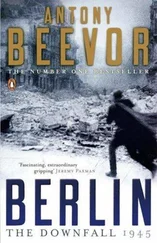South of Evreux, Brigadeführer Fritz Witt, the commander of the 12th SS Panzer-Division Hitler Jugend , had been enjoying a late drink with staff officers in front of a log fire when the first reports of dummy parachutists came in. They dismissed these as yet another of the false alarms which had taken place that spring. But almost as soon as they went to bed, they were woken with more insistent warnings. Witt rang 1st SS Panzer Corps headquarters, but found that they had heard nothing. On his own authority, he ordered the alert for the Hitler Jugend , with the codeword ‘Blücher’. Yet, to their intense frustration, most of his men would spend many hours waiting in their armoured vehicles until Führer headquarters finally agreed to release them for action. Witt nevertheless permitted the 25th SS Panzergrenadier-Regiment to move towards Caen and sent ahead part of his reconnaissance battalion in their six-wheeler armoured cars and BMW motorcycles with sidecars.
Of the British airborne operations that night, Howard’s success with the two bridges was about the only one which went according to plan. Brigadier James Hill, the commander of 3rd Parachute Brigade, had warned his officers before their departure, ‘Gentlemen, in spite of your excellent training and orders, do not be daunted if chaos reigns. It undoubtedly will.’
Major General Richard Gale, the commander of the 6th Airborne Division, had formulated a sound plan. To secure the left flank of the landings, his force needed to occupy and defend the area between the River Orne and the River Dives five miles further east. By destroying five bridges on that eastern side, he could make use of the Dives and the flood plain around it, which the Germans themselves had inundated, as a barrier against armoured counter-attacks. He could then concentrate the bulk of his forces facing southwards to hold off an expected counter-attack from the 21st Panzer-Division. For this they needed anti-tank guns, which would be brought in with the first glider force two hours later.
Another important objective for the 6th Airborne Division was the battery at Merville, onthe far side of the Orne estuary from Ouistreham. RAF air reconnaissance had monitored the preparation of these emplacements for coastal artillery. Large-calibre guns there could wreak havoc on the fleet and the landing ships, as well as Sword beach, the most easterly landing sector. Their massive concrete construction made them virtually impervious to bombing. Lieutenant Colonel Terence Otway’s 9th Battalion of the Parachute Regiment therefore received orders to capture the site and destroy the guns. The barbed-wire defences, minefields and machine-gun positions around them made this an awesome assignment. A bombing raid by Lancasters to soften up the defences was due to go in just before the battalion jumped, then four Horsa gliders carrying an assault group were to land inside the wire and on top of the battery.
Otway’s men had practised the attack many times over on mocked-up positions back in England, but chaos was destined to reign, as their brigade commander had warned. The battalion was dropped all over the place. This was partly due to their aircraft taking evasive action when the flak opened up, but also because the pathfinder group’s Eureka homing devices to guide in the main force had broken on landing. Many paratroopers fell into the flood plain of the River Dives. One of Otway’s men was sucked into a bog and drowned in mud despite efforts to save him. The airborne soldiers had been equipped with duck calls to try to find each other in the dark, but the battalion was so spread out that these could not be heard. Fewer than 160 men out of 600 reached the rendezvous point.
Two sticks of the 9th Battalion had failed to join Otway because they were dropped at Saint-Pair, sixteen miles too far south. They could not believe the silence of the night. Their officer went to a nearby house and woke up the inhabitants to find out where they were. Horrified by the news, he told the men to break up into small groups and try to make their way back to join the battalion, but many of them would be captured on the way. Altogether 192 of Otway’s battalion were still unaccounted for at the end of the battle for Normandy.
Colonel Otway could not wait any longer. He had to complete the mission and send the success signal before 06.00 hours, when the six-inch guns of the light cruiser HMS Arethusa would open fire. To make matters worse, much of their kit had been lost in the jump. Otway’s men had no mine detectors and only a few Bangalore torpedoes for blowing gaps in the barbed-wire entanglements. Otway nevertheless decided to carry on, with only a quarter of his force. His soldier servant, a former professional boxer, proffered a small flask. ‘Shall we take our brandy now, sir?’ he said.
The next blow was to find that the Lancasters coming to soften up the battery had missed their target. Otway had to abandon the set plan completely, above all because the Horsa gliders which were to land on the battery never reached their objective. A young officer and a sergeant crawled ahead through the minefield to mark the way, then the attack went in. The force of 160 men suffered seventy-five casualties in a matter of minutes, but they still seized the emplacements. To their bitter frustration they found only 75 mm guns, not the anticipated 150 mm heavy coastal artillery. Using the plastic explosive which each man carried, they blew the breeches and retired as best they could with their wounded to be out of range before the Arethusa was in position to open fire.
The other seven parachute battalions of Gale’s division were also to be dropped between the rivers Orne and Dives. After the bridges between Bénouville and Ranville had been secured by Howard’s company, the next objective was to destroy the bridges over the Dives to protect the east flank. This was the task of the 3rd Parachute Squadron Royal Engineers, assisted by the battalions dropping on that flank. After the bridges were blown, the 8th Battalion took up positions in the south-east of the area, in and around the Bois de Bavent.
Almost all the battalions dropping that night lost a large amount of kit. Bren guns and PIAT anti-tank launchers suffered damage on landing. In many cases, the jump bag attached to a paratrooper’s ankle was so heavy because of the extra ammunition that either the webbing attachment broke or the bag buried itself deep in the mud of marshy ground. Some soldiers drowned in the ditches of flooded areas adjoining the River Dives. Brigadier James Hill, the commander of the 3rd Parachute Brigade, dropped not far from Cabourg into flooded marshland there. The water was only waist deep, but this did not save him from one minor disaster. All the tea bags which he had brought stuffed inside his trouser legs were ruined. He soon suffered a far more serious blow, when British bombs exploded nearby. As he threw himself sideways, landing on another officer, Hill was wounded in the left buttock. He then saw to his horror a blown-off leg lying in the middle of the path, but it was not his. It belonged to Lieutenant Peters, the man on whom he had fallen. Peters was dead.
Hill’s brigade had suffered the most from inaccurate drops. Low cloud had made navigation difficult and pilots had tried to avoid the flak. Some were also confused because the River Dives, swollen by flooding, looked like the River Orne, and they dropped men on the wrong side. The 1st Canadian Parachute Battalion, bound for the same drop zone as Otway’s 9th Battalion, was also scattered widely for the same reasons. Many of its men fell into the flooded surrounds of the Dives and two sticks were even dropped on the west side of the Orne. Only a small force reached Varaville, where the bridge was to be destroyed. Part of a company helped the 9th Battalion withdraw from the Merville battery, while other detachments, guided through the night by a French girl they met, seized and held the bridge at Robehomme until sappers arrived to destroy it.
Читать дальше











